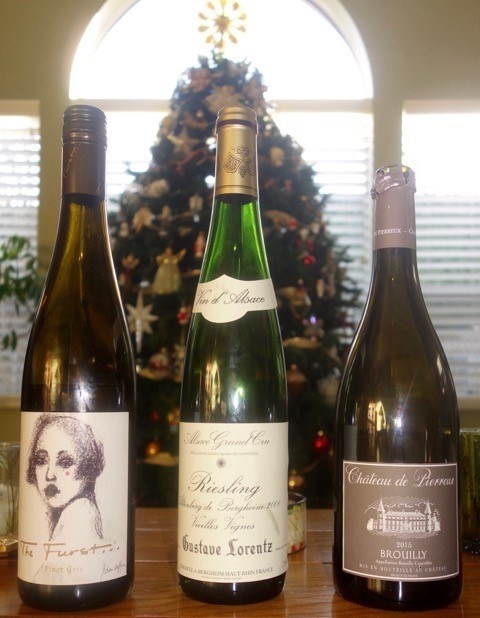Christmas is rapidly approaching and during this season of merry, here are three wines to help you celebrate in style.
The first two come from Alsace, the region which borders Germany and has changed hands many times in the last 150 years. As a result, the wines of Alsace are usually German wines, such as Riesling and Pinot Gris made in a French style, usually bone dry. Like German wines, they come in tall bottles.
Ninety-per cent of wines from Alsace are white, like its neighbour’s wines to the east. Northern vineyards don’t receive the amount of heat to produce hearty red wines.
But they do make delicious whites, which have plenty of acid to pair well with so many foods.
The Furst 2012 Pinot Gris ($24.99) is an off-dry wine with a complex character of honeysuckle, quince, ripe pear, some orange rind, and spice. B.C. makes many tasty Pinot Gris but few have these layers of flavour The Furst does.
It displays a rich texture with excellent balance between the ample fruit and the acidity. Unlike many Alsatian table wines, The Furst is off-dry which makes it a treat to savour on its own. But it’s also well suited for Alsatian dishes, such as Quiche Lorraine and soft cheeses, such as Alsace’s Munster.
Next is an Alsatian white that’s been produced since the 13th century, the Gustave Lorentz 2008 Riesling Grand Cru Altenberg de Bergheim ($39.99). Despite being eight years old, this white is stunning and virile.
Its appearance is a gorgeous golden yellow. There is the signature bouquet of a first class Riesling: lime zest and a hint of diesel. I adore the fresh minerality from the clay and limestone soils with ripe complex flavours of lime, citrus, and peach. As the label accurately describes, it is “elegant, well-balanced, pure, and refreshing.” The long dry finish extends for five minutes if not longer. A wine like this still has years of life ahead of it.
Here is a gastronomic wine par excellence thanks to its lively personality. Enjoy it with Alsatian Choucroute, whether it is the traditional meat version with smoked pork chops, bacon, sauerkraut and a splash of the wine, or the Seafood Choucroute with smoked and fresh fish, mussels with sauerkraut and a pour of the Riesling. As they say in Strasbourg, Alsace, “Très magnifique” or “Sehr Gut.”
Our final wine is another cru but this time from Beaujolais. The very best Beaujolais are produced in the 10 Crus villages. They don’t have Beaujolais on the label, just the village name such as Fleurie, Moulin-a-Vent, and Brouilly.
Named after an extinct volcano, Mont Brouilly, Brouilly is the largest cru appellation in Beaujolais. The Chateau de Pierreux Brouilly ($15.99) is made from old vine Gamay grapes sustainably grown. It is produced like a regular Beaujolais with carbonic maceration which imparts fruitiness but also like a red Burgundy which gives it tannins and structure.
The Chateau de Pierreux’s deep burgundian colour is enchanting. There’s a black cherry bouquet to enjoy with the rich flavour of cherries, plums, blackberries, and black currants. It’s smooth with a structured mouth-feel. Delicious!
Enjoy at Christmas with tourtière, turkey, or prime-rib. Joyeux Noël!
Eric Hanson is a retired teacher and wine educator



